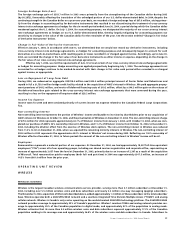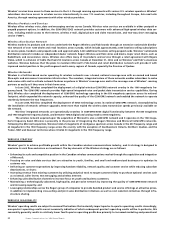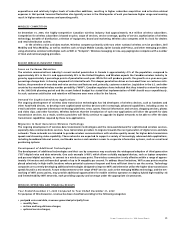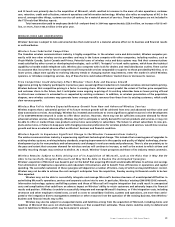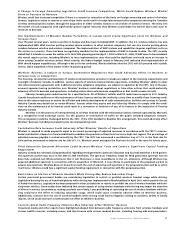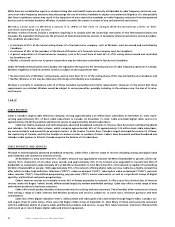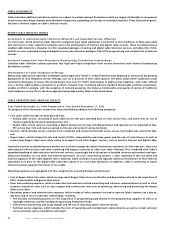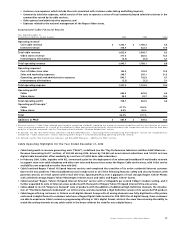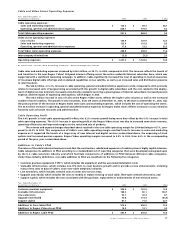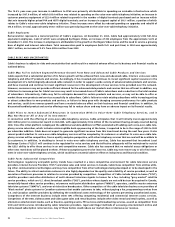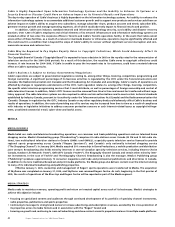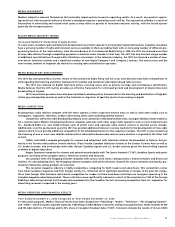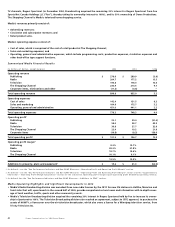Rogers 2004 Annual Report Download - page 34
Download and view the complete annual report
Please find page 34 of the 2004 Rogers annual report below. You can navigate through the pages in the report by either clicking on the pages listed below, or by using the keyword search tool below to find specific information within the annual report.
32 Rogers Communications Inc. 2004 Annual Report
While there are no definitive reports or studies stating that such health issues are directly attributable to radio frequency emissions, con-
cerns over radio frequency emissions may discourage the use of wireless handsets or expose us to potential litigation. It is also possible
that future regulatory actions may result in the imposition of more restrictive standards on radio frequency emissions from low-powered
devices such as wireless handsets. Wireless is unable to predict the nature or extent of any such potential restrictions.
Wireless Could Lose its Wireless Licences if it, RWCI or RCI Fails to Comply With Governmental Limits on Non-
Canadian Ownership and Control
Wireless’ wireless licences include a condition requiring it to comply with the ownership restrictions of the Telecommunications Act
(Canada), the legislation that governs the provision of telecommunications services in Canada by telecommunications service providers.
This condition provides that:
• A minimum of 80% of the issued voting shares of a licenced carrier company, such as Wireless, must be owned and controlled by
Canadians;
• A minimum of 80% of the members of the Board of Directors of a licenced carrier company must be Canadians;
• A parent corporation of a licenced carrier company, such as RCI, must have at least 66 2/3% of its voting shares owned and controlled
by Canadians; and
• Neither a licenced carrier nor its parent corporation may be otherwise controlled in fact by non-Canadians.
Under the Radiocommunication Act (Canada), the legislation that governs the licencing and use of radio frequency spectrum in Canada,
Wireless’ eligibility to hold its wireless licences is subject to the requirement that:
• No more than 20% of Wireless’ voting shares, and no more than 331/3% of the voting shares of RCI, may be held by non-Canadians; and
• Neither Wireless, or RCI may be otherwise effectively controlled by non-Canadians.
Wireless is currently in compliance with all of these Canadian ownership and control requirements. However, to the extent that these
requirements are violated, Wireless would be subject to various penalties, possibly including, in the extreme case, the loss of its wire-
less licences.
CABLE
CABLE BUSINESS
Cable is Canada’s largest cable television company, serving approximately 2.25 million basic subscribers at December 31, 2004, repre-
senting approximately 29% of basic cable subscribers in Canada. At December 31, 2004, Cable provided digital cable services to
approximately 675,400 households and Internet service to approximately 936,600 subscribers.
Cable has highly-clustered and technologically advanced broadband networks in Ontario, New Brunswick and Newfoundland
and Labrador. Its Ontario cable systems, which comprise approximately 89% of its approximately 2.25 million basic cable subscribers,
are concentrated in and around three principal clusters: (i) the Greater Toronto Area, Canada’s largest metropolitan centre; (ii) Ottawa,
the capital city of Canada, and (iii) the Guelph to London corridor in southern Ontario. Cable’s New Brunswick and Newfoundland and
Labrador cable systems in Atlantic Canada comprise the balance of its subscribers.
CABLE PRODUCTS AND SERVICES
Through its technologically advanced broadband networks, Cable offers a diverse range of services including analog and digital cable
and residential and commercial Internet services.
At December 31, 2004, more than 93% of Cable’s network was upgraded to transmit 750 MHz of bandwidth or greater, which rep-
resents 100% completion of all urban areas served, and approximately 85% of its network was upgraded to transmit 860 MHz of
bandwidth, as compared to approximately 39% at 860 MHz at December 31, 2003. More than 96% of its network is capable of transmitting
550 MHz of bandwidth or greater. With approximately 99% of its network offering digital cable services, Cable has a highly-competitive
offer which includes high-definition television (“HDTV”), video-on-demand (“VOD”), subscription video-on-demand (“SVOD”), personal
video recorder (“PVR”), time-shifted programming, pay-per-view (“PPV”) movies and events, as well as a significant lineup of digital
specialty, multicultural and sports programming.
Cable’s Internet services are available to over 96% of homes passed by its network. It offers up to four distinct tiers of Internet
services under the Rogers Yahoo! brand, differentiated largely by modem bandwidth settings. Cable also offers a wide range of data
and Internet products to business customers.
Cable offers multi-product bundles at discounted rates to existing and new customers. These bundles allow customers to choose
from among a range of cable, Internet and Wireless products and services, subject to, in some cases, minimum purchase and term
commitments.
Cable also offers digital videodisc (“DVD”), videocassette and video game sales and rentals through Rogers Video, Canada’s sec-
ond largest chain of video stores. There were 294 Rogers Video stores at December 31, 2004. Many of these stores provide customers
with the additional ability to acquire Cable and Wireless products and services, to pay their cable television, Internet or Wireless bills
and to pick up or return Rogers digital cable and Internet equipment.



